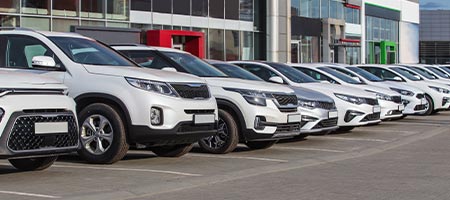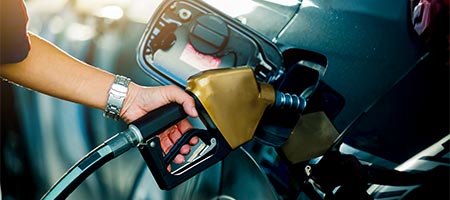The latest industry discussions.
VEHICLE SAFETY SYSTEMS STRUGGLE TO "SEE" IN BAD WEATHER +
There’s no question that safety systems in new vehicles prevent crashes and keep drivers safe. However, as drivers tend to rely more and more on these systems, it’s important to note that adverse weather conditions can affect the way they perform. A recent AAA research study showed that moderate to heavy rain can impede these systems — especially automatic emergency braking and lane-keeping assistance, two of the most common.
During closed-course testing, the study found that the sensors and cameras used to see road markings, other cars, pedestrians, and obstacles were affected most by moderate to heavy rain. Vehicles equipped with automatic emergency braking traveling at 35 mph collided with a stopped vehicle one-third (33%) of the time in these conditions. Lane-keeping assistance fared worse, with test vehicles departing their lane 69% of the time.
Most testing of these safety systems — known as Advanced Driver Assistance Systems (ADAS) — is performed in ideal operating conditions when they work best and the results are easily replicated. However, AAA believes testing standards must incorporate the real-world conditions that drivers encounter every day.
The research also simulated other conditions — such as bugs and dirt — to measure the impact on ADAS. They found that the cameras and sensors can also be affected by a dirty windshield, so drivers should clean those regularly to make sure there are no obstructions.
While advanced vehicle technology can improve safety, AAA reminds drivers to stay alert behind the wheel and be ready to take over at a moment’s notice.
THE ACCURACY OF IN-DASH FUEL DISPLAYS +
How many times have you used the “miles to empty” display to decide when to fill up your tank? Or tested the limits of the “low fuel” warning on the dashboard? According to a study by AAA, you may be tempting fate. After testing the accuracy of in-dash fuel economy displays in vehicles, they found the error rate varied greatly from vehicle to vehicle, from -6.4% to 2.8%. The negative number indicates that the vehicle overestimated fuel economy by 6.4%, or 2.2 mph, while another underestimated it by 2.8%, or 0.9 mph.
What does this mean for consumers? Each vehicle reacts differently to changes in driving and is impacted by driving style and conditions. The range estimation is affected by the vehicle’s most recent driving conditions, so can vary greatly if you’re cruising at highway speeds or stuck in traffic jams.
The bottom line: don’t rely on in-dash displays to determine when you should fill up. AAA recommends filling up when the gas gauge reaches a quarter of a tank to avoid a potentially risky situation, as well as to avoid damaging your fuel pump by regularly running on empty.
Other tips to maximize fuel economy:
- Plan ahead and run multiple errands in one trip. Try to avoid times of day when traffic is heavier.
- Avoid hard acceleration to maximize fuel economy.
- Keep your tires inflated to the recommended pressure found inside the driver’s side door or in the owner’s manual.
- Remove bulky items from your car and minimize the use of roof racks and special carriers when not in use. Smaller cars will experience a bigger reduction in fuel economy than larger models designed to carry more weight.
- Minimize use of air conditioning; open windows have less effect on fuel economy than the engine power required to operate the AC compressor.
- In hot and sunny weather, park in the shade or use a windshield screen to lessen heat buildup inside the car, eliminating the need to use the AC to cool down the car.
YOUR DRIVING COSTS CALCULATOR +
AAA CAR GUIDE +
AAA has released the Car Guide to help consumers navigate the changing automotive marketplace. The annual report ranks and rates the newest vehicles available for sale, including alternative fuel vehicles. In addition to vehicle evaluation, the guide covers a number of pertinent automotive topics in detail—for example, the latest advanced safety features, how to properly maintain your vehicle, and new vehicles coming to market in the next few years.
WHO ARE YOU CALLING A LIGHTWEIGHT? +
Nearly nine out of 10 consumers agree that automakers should continue to improve the fuel efficiency for all vehicles, and believe that fuel economy is the area with the most room for improvement in their current vehicle.*
More and more, manufacturers are adopting aluminum alloys and other lightweight materials to shave pounds off their vehicles. In fact, the amount of aluminum used in cars is expected to increase significantly by 2025, according to a recent study published by the consulting and research firm Ducker Worldwide. Components are being retooled in lighter high-strength steel, aluminum, plastic and composites. Every pound counts; studies have shown that reducing vehicle weight by 10% can improve gas mileage by 6 to 8%.
The new BMW i3 electric car may be the poster child for light weighting. The compact four-seater weighs a svelte 2,635 pounds, despite carrying a 500-pound battery pack. This was accomplished by using a carbon fiber passenger compartment and aluminum subframes that carry the battery and powertrain.
Despite using some similar materials, you needn’t worry that modern vehicles will crumple like soda cans. Lightweight cars and trucks will still be safe thanks to high-strength metal alloys and high-tech composites such as carbon fiber. These materials can be just as strong as heavier materials, and with proper engineering, they are often even better at absorbing collision impact energy.
Collision repair costs and insurance premiums may also go up due to special training and equipment needs, though some experts believe the difference will be minor since the portion of most insurance premiums devoted to collision repair is small. In the end, both consumers and the environment will benefit from lightweight vehicles. That’s a diet we can probably all agree on.
*Source: Consumers Union National Vehicle Fuel Economy Poll, June 2017.
THE SKINNY ON VEHICLE-TO-VEHICLE COMMUNICATIONS +
Unexpected emergencies and ineffective driver reactions result in millions of crashes every year. The National Highway Traffic Safety Administration projects that V2V systems could help prevent up to 81% of collisions involving drivers not impaired by drugs or alcohol.
In more advanced V2V systems, the vehicle could take control of the brakes and/or steering to avoid a collision if the driver fails to react in time. These systems also may employ vehicle-to-infrastructure (V2I) communications that allow drivers to receive driving conditions from traffic lights, road signs or even the highway. Notifications might be made for traffic jams, changing speed limits, or height restrictions on bridges and tunnels.
Cadillac recently introduced a V2V system in their 2017 CTS Sedan, and Volkswagen recently announced plans to equip its vehicles with the technology beginning in 2019. As the number of V2V-equipped vehicles grows, shared information also could be used to reduce traffic congestion, improve fuel economy and cut emissions.
The smarter cars become — whether by parking themselves, providing maintenance reminders or indicating an approaching car in your blind spot — the more people are concerned with privacy. Cars can record massive amounts of data, including driving habits and routes traveled; knowing how and where this information is transferred is critical to its adoption. The vehicles’ ability to resist “hacking” should be a number one priority with vehicle manufacturers.
In June 2017, the National Highway Traffic Safety Administration and the Federal Trade Commission held a joint conference in Washington, D.C. to examine privacy and data issues in advanced car technologies. Panelists and cybersecurity experts agreed that manufacturers need to be vigilant about their methods of encryption and authentication, and must actively address any discovered vulnerabilities.
As automakers include V2V technology in their vehicles, we’ll be monitoring the issues that arise. To be continued…
CONNECTED CARS +
You may not be aware, but every time you use your vehicle’s navigation or touch screen audio systems, get a diagnostics report or maintenance reminder, or have your doors unlocked remotely by OnStar, you’re using telematics. Telematics is the use of wireless information to enable your car to interact with the outside world.
For the most part, telematics has made driving safer and more enjoyable with enhancements such as:
- Emergency assistance, such as calling the police, a tow truck or an ambulance.
- Insurance support, by providing vehicle location or disabling engine operation to help recover a stolen vehicle.
- Travel guidance via navigation services, including real-time traffic information and automatic trip rerouting to minimize delays.
- Travel information, such as points of interest, weather forecasts, fuel stations/prices, hotel and dining reservations, and more.
- Car care extras, including maintenance reminders, vehicle health reports and diagnostic information.
- Parenting assistance services, such as monitoring teen drivers and getting alerts if restrictions are violated.
However, any information that can be scanned from a car’s computer system can be transmitted. This includes engine performance, vehicle location, even the driver’s weight. For example, telematics can monitor driving behavior. Some big insurance names use this information to offer discounts based on how you drive, when you drive and where you drive. This usage-based car insurance (UBI) provides more competitive auto insurance quotes if the technology deems you a “safe driver.” While this may be economical for most AAA members, several experts have raised concerns about potential discrimination, privacy issues and the potential for unfair surcharges.
AAA SPILLS THE TRUTH ABOUT OIL +
If Dorothy oiled the Tin Man with synthetic oil, he probably wouldn’t have rusted on the way to the Emerald City. That’s because new research by AAA Automotive Engineering on engine oil quality revealed synthetic oil outperformed conventional oil by an average of nearly 50%. What does this mean for members? For only about $5 more a month, synthetic oil will provide significantly better engine protection than conventional oil.
While consumers don’t generally want to spend additional money on synthetic oil changes (about $70 vs. $38 for a conventional oil change), the long-term benefits are worth considering.
Synthetic oils have superior resistance to deterioration, and AAA’s research showed they would especially benefit newer vehicles with turbocharger engines and vehicles that tow heavy loads, operate in extreme temperatures, or are frequently driven in stop-and-go traffic.
The study focused on eight industry-standard ASTM (American Society for Testing and Materials) tests that evaluated the quality of both synthetic and conventional engine oils in terms of shear stability, deposit formation, volatility, low-temperature pumpability, oxidation resistance and oxidation-induced rheological changes.
TOUGH TALK ON TREADS +
New research from AAA reveals that worn tires can cause a deadly hazard for motorists in wet weather. Performance testing at various highway speeds revealed that average stopping distances are increased a staggering 43% - an additional 87 feet - for worn tires, compared to new.
The key difference is traction. Tire treads literally connect a car to the road, and in wet conditions worn tires will completely lose contact and skid (or hydroplane). Current industry guidelines and state laws frequently recommend that drivers wait until tread depth reaches 2/32” to replace tires. Yet AAA’s study tested new tires against tires worn to 4/32”- higher than most recommendations - and found increased stopping distance, and a reduction in handling ability on wet pavement.
A simple test is to slip an upside-down quarter between tire grooves - on the outside, in the middle, and on the inside of the tire. If you can see all of Washington’s head on the quarter, you need to start shopping for tires.
View the complete report.
ENGINE STOP-START SYSTEMS ARE HEADED YOUR WAY +
For years, hybrid vehicles have used stop-start technology to improve fuel efficiency. This means the engine shuts down when the vehicle is at a complete stop – such as in traffic or at a stop light. The car’s accessories, such as lights, wipers, audio and climate control, keep operating as usual. As soon as the driver releases the brakes, the engine restarts automatically. It takes some getting used to, but the intention is to reduce fuel consumption and exhaust emissions. More and more, this stop-start technology is now appearing on conventional gasoline engine vehicles as well.
Depending on the price of gas and individual driving conditions, annual fuel cost savings are estimated at around $167 – more than 12,000 miles per year in a vehicle that averages 20 mpg. Stop-start systems, which add about $300 to the traditional vehicle powertrain, can pay for themselves in just two years. However, there is one big trade-off.
A stop-start system requires a special, high-capacity battery, which can cost twice as much as a traditional battery. When the engine shuts off in a stop-start system, the battery must assume the load for all the electrical needs, including charging ports, navigation and infotainment systems, lights, climate control and more. And, an engine that experiences frequent start-ups (potentially hundreds per day) requires extra battery capability.
Stop-start technology is growing fast, and most manufacturers have indicated this technology will be standard equipment on models over the next few years.
PROS AND CONS OF ADVANCED DRIVER ASSISTANCE SYSTEMS +
It may seem like something from a sci-fi movie, but the concept of vehicles that drive themselves is closer than you think. Many companies, including Tesla, Mercedes, BMW and even Apple are actively working on autonomous car technology. However, while completely driverless vehicles are not yet commonplace on our roads, more and more models are incorporating technology to help the driving process. This technology, known as Advanced Driver Assistance Systems (ADAS), is not designed to replace a driver, but to help the driver respond to potentially dangerous situations.
ADAS use ultrasonic, radar, laser, camera, thermal and infrared sensors to monitor the outside of a vehicle. Onboard computers use the information to take action, which could be as simple as illuminating a warning light when a car enters a driver’s blind spot. More complex systems take control of the vehicle, such as applying the brakes and/or steering to avoid a collision.
The potential for ADAS to save lives is huge. Human error causes the vast majority of the 2.4 million injuries and 35,000 deaths from traffic crashes every year. Research shows fewer claims for vehicles with ADAS vs. identical vehicles without the technology, demonstrating the systems are working to prevent or reduce the severity of crashes. Putting a dent in those numbers would have a huge effect.
However, a new study from the AAA Foundation for Traffic Safety found that most drivers don’t fully understand how ADAS works, and tend to over-rely on the systems. AAA recommends consumers get more education about ADAS at the point of sale (from the dealer), as they expect ADAS to be incorporated as standard equipment in most new car models, paving the way for fully autonomous vehicles in (perhaps) the not-too-distant future.
SPOTLIGHT ON HEADLIGHTS +
The AAA automotive engineering team recently conducted research on halogen headlights — the kind on more than 80% of vehicles on the road today — with surprising results. Examining the illumination provided at low- and high-beam settings, AAA determined that halogen headlights on the low-beam setting are insufficient when driving at highway speeds on roads with no additional overhead lighting.
Simple math bears this out. At 55 mph, a driver requires about 500 feet of roadway to perceive an obstacle, react to it, and bring the car to a complete and safe stop. Yet halogen lights illuminate only 300 feet on low beams, leaving about 200 feet of dark road where obstacles are unseen — with no time for drivers to react. In fact, most low beams only help you stop in time if you’re driving no faster than 35 mph.
Late model vehicles with newer high-intensity discharge (HID) lights illuminate up to 400 feet; and light-emitting diode (LED) lights only illuminate up to 450 feet. But even these newer models are lacking.
What can drivers do now? Thankfully, most highways are dotted with lights to make up for the headlight shortfall. If overhead lights are not present, using high beams can improve sight distances by an average of 28%. Drivers should get in a habit of using their vehicle’s high beams, making sure to dim them in the presence of other drivers.
AAA continues to research this issue. The automotive engineering group recently studied Adaptive Driving Beam (ADB) headlights, which are currently used in Europe and Canada, but are illegal in the U.S. ADB headlights — also called smart headlights — shine as brightly as traditional lights that have high beams, but come with new technology that prevents glare from shining into oncoming vehicles.
Another big problem with headlights is visibility. Pitted, yellow and hazy lights significantly reduce output, and can scatter light instead of focusing it on the roadway. A basic headlight restoration kit — available at auto supply stores — doubles the light intensity and reduces light scattering. For more damaged lights, a AAA Approved Auto Repair facility can do more aggressive restoration or even replace them if necessary.
ENGINE EFFICIENCY AND FUEL SAVINGS OF TODAY +
One of the most important features for consumers purchasing a new car is engine efficiency. This term describes the percentage of chemical efficiency in gas that is converted to mechanical efficiencies that move the car. The higher the rate of efficiency, the more effectively you’re using the gas put into your car.
While today’s vehicles provide better fuel economy than just a few years ago, more than half of the gas you pump into your car goes to waste. That means roughly 60 cents out of every dollar you spend on fuel does nothing to move your vehicle down the road.
Internal combustion automobile engines aren’t very efficient, using less than 40% to power the car and a small amount to power engine accessories. The rest is thrown away as “waste heat.” Consider this too: The AAA annual analysis of driving costs reveals that per-mile fuel costs are higher than per-mile maintenance, repair and tire costs combined. So, while you’re spending most of your driving costs on fuel, more than half goes to nothing but hot air.
Manufacturers continue to try to lessen the gap in engine efficiency, working on new technologies such as stop-start systems, low RPM operation, turbocharging and more. Consumers, too, can take steps of their own to improve efficiency and save money on fuel.
If you’re looking for a new car, consider models that have the highest EPA-estimated fuel economy ratings. You might want to consider a model that uses the stop-start system that shuts down the engine when the car is stopped in traffic. While it takes some getting used to, this system can deliver a gain in efficiency, especially if your commute is low speed, stop-and-go traffic.
Consumers should examine their own driving behavior as well. Moderate acceleration at low RPMs, staying within the speed limit, coasting to stopped traffic, and using cruise control to maintain a safe, legal speed, will all stretch your tank of gas further. Also, simple car maintenance — such as inflating tires to their proper level, ensuring you’re using the recommended motor oil, and making sure your gas cap has a proper seal — can also improve your driving efficiency.











